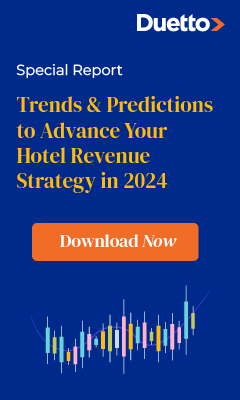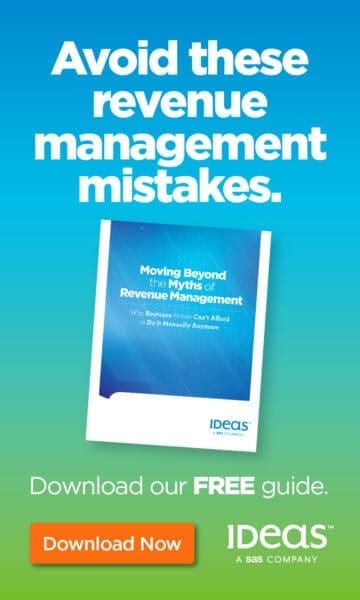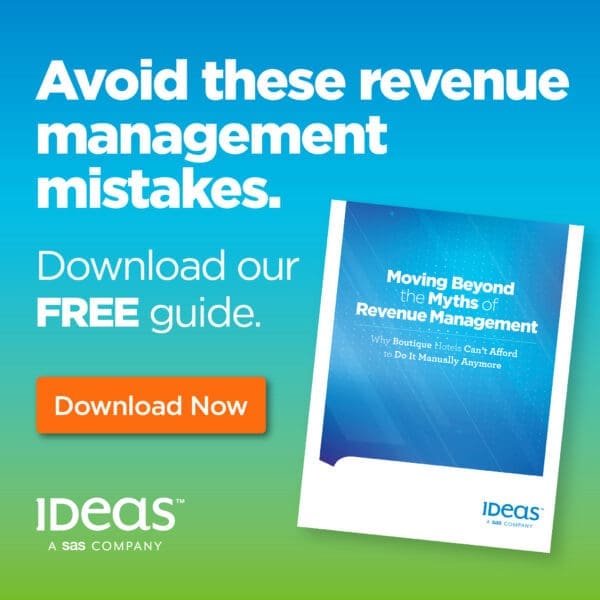 In an ever-changing technological landscape, it can be challenging for hoteliers to keep up with latest software advances, how these can impact key workflows within a property and its overall financial performance. While the advancement of operational technologies can be overwhelming, it is important hoteliers understand that from demand-based forecasting to data-driven pricing and inventory control decisions, the powerful analytics in advanced revenue management systems are a significant performance driver for a hotel’s profitability—a factor that should be increasingly a focus, given that many hoteliers are in the middle of their own budgeting periods.
In an ever-changing technological landscape, it can be challenging for hoteliers to keep up with latest software advances, how these can impact key workflows within a property and its overall financial performance. While the advancement of operational technologies can be overwhelming, it is important hoteliers understand that from demand-based forecasting to data-driven pricing and inventory control decisions, the powerful analytics in advanced revenue management systems are a significant performance driver for a hotel’s profitability—a factor that should be increasingly a focus, given that many hoteliers are in the middle of their own budgeting periods.
Analytics help hoteliers make better use of their data, enhancing the effectiveness of their forecasting capabilities to explore, predict and optimise revenues. Analytics assist hoteliers to explore why patterns and trends occur so they can predict whether to anticipate similar or different results moving forward. By determining why specific results emerge—and if a property can expect them to continue—hoteliers can enhance their decision-making, driving better revenue performance.
Advance your hotel demand forecasting
Revenue management systems have traditionally used a limited number of forecasting models at a level defined manually by users. High-performance forecasting, on the other hand, relies on hundreds of advanced forecasting models where the most appropriate model is selected by the system automatically. Then the forecast model parameters are calibrated to understand the impact of the specific price sensitivities, no-shows, cancellations, booking curves, etc. within the forecasting group.
Analytics can be employed to solve a variety of challenges, including adapting the forecasts to demand shifts and understanding demand as a function of price (the impact of price changes on the demand that exists for the room product).
Why does this matter? Let’s say we’re trying to price our rooms for certain length-of-stay patterns that show similar behavior. It may be better to estimate them together because we can combine their data and build a more robust basis for forecasting. Conversely, if we’re trying to estimate price elasticity, it may not be a good idea to pool room types from distinct classes because a deluxe and a standard may show different behavioral patterns in terms of willingness to pay.
Utilise analytical market segment analytics
Typically, revenue management systems collate hotel transactional data, aggregating this based on pre-defined fields (e.g., market segments or room types). Unfortunately, important information can be lost as a result of this grouping process—in particular, the information regarding how rates are priced and controlled. For example, many hotels consider OTA as a market; however, OTA segments combine best available rate, discounted rate, promotions and packages. This mix of business types will add complexities to a hotelier’s ability to forecast accurately.
Analytical market segmentation allows a revenue management system to separate the transactions based on various attributes (i.e., dynamic rate or static rate, full value bar or discounted, fenced or unfenced) that influence particular demand types and customer purchasing behaviors. Meanwhile, forecasts can still be made available to system users in a manner consistent with their current market segments and reporting requirements.
But why does this matter? Imagine a hotel has two corporate rates. One is contracted at a fixed price with last room availability for standard rooms only. Meanwhile, another corporate rate is contracted at a guaranteed 10 percent off the best available rate and it’s fully yieldable, meaning the hotel can restrict it as required and the price can be managed when the public pricing is changed.
From a business perspective, these two rates will often end up in the same market segment in the property management and central reservations systems simply because they are both contracted corporate rates. However, from a forecasting and optimisation perspective, hoteliers need to differentiate between price-sensitive (dynamically priced) products and price-insensitive (fixed price) products as their booking behaviours are distinctly different.
Manage demand of all yieldable market segments and rates
The complex business mix many hotels have to manage—a mixture of market segments, fixed and dynamically priced rates, last room availability and yieldable rates and a variety of complex booking conditions (or fences)—means it is important to manage demand of all yieldable market segments and rates, both dynamically priced and fixed priced, on an ongoing basis.
Yieldable rates are the rates that can be controlled by a hotel or revenue management system. Non-yieldable rates refer to the rates that cannot be closed by hotel or revenue management even when forecast demand is high, for example, corporate contracted rates with last-room-availability terms.
To practice revenue management effectively, hoteliers need to adopt an integrated approach to optimisation: optimising for both pricing and availability. The price-sensitive and the price-insensitive products, a hotel’s fixed and dynamic corporate negotiated products and its retail (public priced) product all consume the same limited bedroom stock. The result is that a hotel’s pricing needs to understand the trade-offs between the two different segments and optimise them together.
Leverage analytics to optimise business results
Emerging technologies are increasingly changing the practice of how hotels price their rooms and services to potential guests. Through using powerful analytics provided by advanced revenue management solutions, hoteliers can achieve new levels of precision in their forecasting and better manage demand to optimise occupancy, rate and profits.
About the author

Tracy Dong is the Lead Advisor, APAC at IDeaS Revenue Solutions.





























